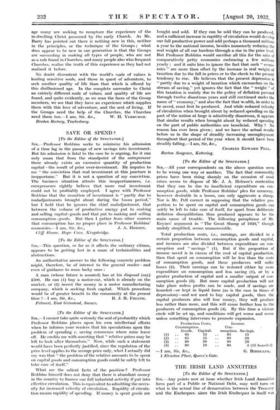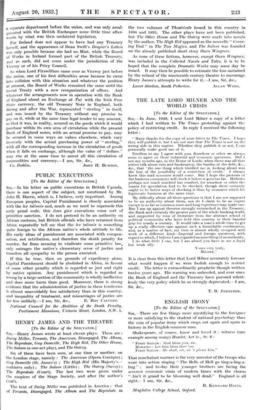THE IRISH LAND ANNUITIES
[To the Editor of the SPECTATOR.] Sin,--Any points now at issue whether Irish Land Annuities form part of a Public or National Debt, may well turn on what is the actual line of demarcation between the Treasury and the Exchequers since the Irish Exchequer in itself was
a separate department before the union, and was only amal- gamated with the British Exchequer some little time after- wards by what was then unilateral legislation.
For Ireland does not appear to have had any Treasury herself, and the appearance of Dean Swift's Drapier's Letters was only possible because she had no Mint, while the Board of Works in Ireland formed part of the British Treasury, and as such, did not come under the jurisdiction of the Viceroy or of his Privy Council.
So when Lord Fitzwilliam came over as Viceroy just before the union, one of his first difficulties arose because he came into collision with this situation and whatever the position at present, the Board of Works remained the same until the recent Treaty with a new reorganization of offices. And whatever- the arrangements now in operation with the Bank of England about an Exchange at Par with the Irish Free state currency, the old Treasury Note in England, both during and after the War, represented " sterling " in itself, and was issued by the Treasury without any promise to pay on it, while at the same time legal tender to any amount, so that it was, in reality, secured on the goods which it would purchase within its own area of circulation while the present Bank of England notes, with an actual promise to pay, may be secured in some ways on values elsewhere, which vary inversely with the actual purchasing power of " sterling," with all the corresponding increase in the circulation of goods when it falls on exchange, although the value of " dollars " may rise at the same time to arrest all this circulation of commodities and currency.—I am, Sir, &c.,































 Previous page
Previous page